Tuesday, 25 April 2017
| Room 316A |
08:15 - 10:15 |
Moderators: Malgorzata Marjanska, Itamar Ronen |
Slack Channel: #s_mrs_molecular
Session Number: O43
08:15
 |
0402.
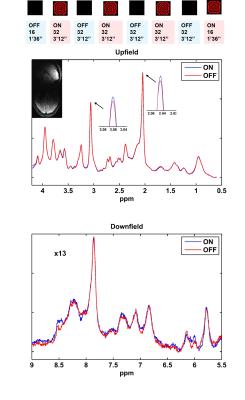 |
Functional Magnetic Resonance Spectroscopy (fMRS) using metabolite cycled semi-LASER at 9.4T: a pilot study 
Ioannis-Angelos Giapitzakis, Nikolai Avdievitch, Saipavitra Murali Manohar, Nicole Fichtner, Roland Kreis , Anke Henning
The purpose of this work is to explore the potentials of fMRS under a visual stimulation at 9.4T using a metabolite cycled (MC) semi-LASER sequence. The MC technique allows for simultaneous acquisition of water and metabolite spectra enabling the synchronous investigation of dynamic alternations of BOLD signal and metabolite levels. Correlation of FWHMCr and FWHMNAA with SNRwater is demonstrated. The influence of misaligned subtraction is evaluated and the requirement of linewidth, frequency and phase-correction is highlighted. Finally, all previously reported alterations of upfield metabolites are confirmed and for first time also potential difference of downfield metabolites are observed.
|
08:27
|
0403.
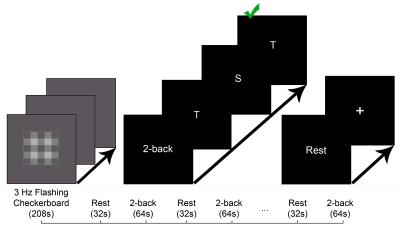 |
Glutamate modulation during working memory task performance: A functional proton magnetic resonance spectroscopy study in healthy adult volunteers 
Eric Woodcock, Chaitali Anand, Jonathan Lynn, Dalal Khatib, Jeffrey Stanley
Glutamate is involved in excitatory neurotransmission and oxidative metabolism. In vivo glutamate measurements at task-relevant temporal resolution are possible using functional proton magnetic resonance spectroscopy. The present study quantified glutamate levels in the dorsolateral prefrontal cortex during working memory task performance and interspersed periods of rest. Results demonstrated that our approach was feasible and quantification of glutamate levels was reliable at 32s temporal resolution. Statistical analyses demonstrated that glutamate levels were elevated during working memory task performance (relative to rest), consistent with our hypotheses. Elevated glutamate levels during task performance likely reflect increased oxidative metabolism due to excitatory neurotransmission.
|
08:39
 |
0404.
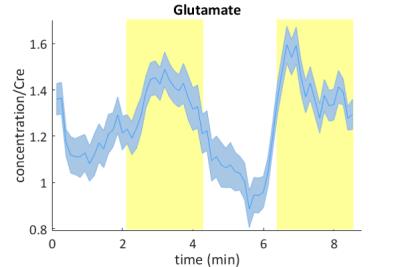 |
Dynamic changes of glutamate detected by functional MR spectroscopy in human visual cortex in regions with positive and negative BOLD response 
Miguel Martínez-Maestro, Christian Labadie, Ioannis Giapitzakis, Harald Möller
Dynamic changes of metabolite concentrations have been presented in human visual cortex in response to stimulus that induce a positive BOLD response (PBR). The present study compares the metabolic profile of the positive and the negative bold response (NBR). The application of different fMRS block designs showed a significant increase in Glutamate (+7.3%) during the PBR stimulation paradigm in agreement with previous studies and a decrease (-6.6%) during the NBR, which provides new information about its underlaying mechanisms.
|
08:51
 |
0405.
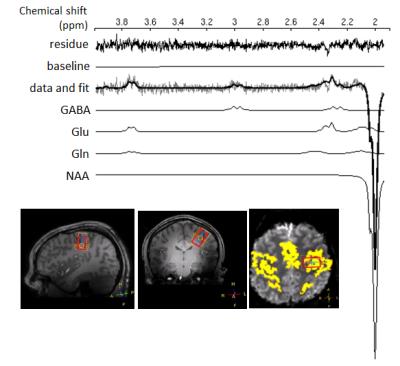 |
Activation induced changes in GABA: functional MRS at 7T with MEGA-sLASER 
Chen Chen, Hilmar Sigurdsson , Sophia Pépés, Dorothee Auer, Penny Gowland, Paul Morgan, Stephen Jackson
To investigate changes in GABA levels in human motor cortex in response to the hand clenching task, the macromolecule-corrected MEGA-sLASER sequence was used in functional MRS (fMRS) experiments conducted at 7T. During motor activation, the total creatine (tCr) signal remained stable, while a significant transient increase in GABA/tCr (20%±11%) was observed. The measured increase in Glx/tCr (12%±6%) was higher but consistent with changes reported for Glutamate. With consistent editing performance for GABA detection and the advantage of visually identifying GABA peaks in spectra, this spectral editing approach showed its potential for future fMRS studies of GABA.
|
09:03
|
0406.
 |
Detection of Changes in the Creatine Kinase Cycle Rate in the Human Visual Cortex During Visual Stimulation with Filter Exchange 1H MR Spectroscopy (FEXSY) at 7T 
Casper Wolf, Andrew Webb, Itamar Ronen
We selectively monitored the Cr/PCr exchange rate during visual stimulation using filter exchange spectroscopy (FEXSY), a pulse sequence sensitized to exchange between two pools with different diffusion coefficients. A Significant difference was observed between the filtered and non-filtered D(tCr) during rest, and vanished during stimulation, indicating an increase in the rate of creation of a fast-diffusing species in the tCr complex during stimulation. This suggests an increased production of Cr from PCr resulting from increased metabolic demand, or an increase in “free” vs. enzyme-bound tCr. The non-filtered ADC of NAA significantly increased during activation, suggesting microstructural change during activation.
|
09:15
 |
0407.
 |
Dynamics of lactate levels measured by functional proton magnetic resonance imaging in the rat somatosensory cortex upon increasing electrical hindpaw stimuli. 
Aline Seuwen, Aileen Schroeter, Markus Rudin
MRSI in mice reveals changes in glutamate and lactate levels in somatosensory brain areas elicited by electric hindpaw stimulation. Using increasing stimulus amplitudes, lactate signals consistently decreased with increasing stimulus strength. This surprising result might reflect accelerated lactate clearance triggered by a generalized CBF increase in response to hindpaw stimulation, previously observed in this species. In contrast to mice, Lac levels in the contralateral somatosensory cortex of rats significantly increased with stimulus amplitude reflecting increased glycolytic activity and no obvious indication of increased lactate clearance. Despite the difference in Lac responses, similar Glu responses have been observed in both species.
|
09:27
|
0408.
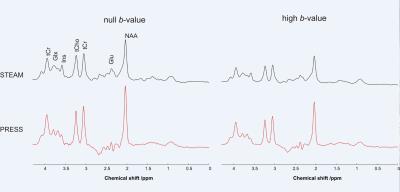 |
Apparent diffusion coefficients of the five major metabolites in the human brain at 3 T 
Dinesh Deelchand, Edward Auerbach, Malgorzata Marjanska
The goal of this study was to measure the apparent diffusion coefficients (ADC) of five main metabolites in the human brain at 3 T using PRESS and STEAM sequences where measurement biases due to cross-terms were avoided by using positive and negative diffusion gradient polarity. This study shows that comparable trace/3 ADC values for total N-acetyl aspartate, total creatine, total choline, glutamate and myo-inositol can be successfully measured with both acquisition methods on a clinical scanner with STEAM providing slightly better quantification precision for J-coupled metabolites.
|
09:39
|
0409.
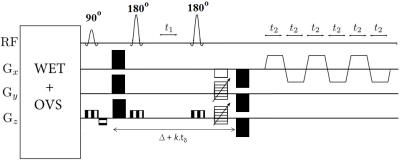 |
Diffusion-Weighted Echo Planar J-resolved Spectroscopic Imaging - permission withheld
Manoj Sarma, Zohaib Iqbal, Andres Saucedo, Paul Macey, M. Albert Thomas
Diffusion weighted spectroscopy enables investigation of brain intracellular microstructure in-vivo. Here we implemented a novel technique called diffusion-weighted echo-planar J-resolved spectroscopic imaging (DW-EPJRESI) which is capable of giving information about metabolite diffusivity beyond NAA, Cr and Cho in multiple brain locations simultaneously. The technique was evaluated in a brain phantom and four healthy volunteers. Highly reproducible diffusion-weighted metabolite maps were obtained. The ADC values were in good agreement with previous reported values. Further optimization of the DW-EPJRESI sequence will become more practical for clinical use.
|
09:51
 |
0410.
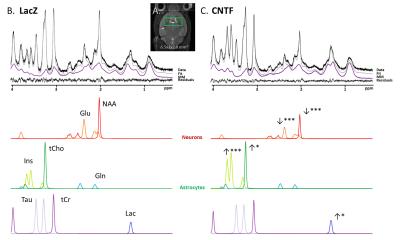 |
Probing alterations of cellular metabolism and structure in CNTF-induced mouse model of astrocytic activation using in vivo MRS and diffusion-weighted MRS 
Clemence Ligneul, Marco Palombo, Edwin Hernandez Gazon, Martine Guillermier, Sueva Bernier, Kelly Ceyzeriat, Laurene Abjean, Julien Flament, Carole Escartin, Julien Valette
In this work we use in vivo MRS and diffusion-weighted MRS (DW MRS) on a model of astrocytic activation induced by the ciliary neutrophic factor (CNTF) in mice striatum. We observe a massive metabolic remodeling in CNTF mice in comparison with control mice. We demonstrate the intrinsic potential of DW MRS to detect alterations in cellular structure by measuring substantial variations in diffusion properties of astrocytic and neuronal metabolites. Modeling suggests significantly larger astrocytic processes, consistently with astrocytic hypertrophy as observed by microscopy in the context of activation.
|
10:03
|
0411.
 |
Comparison diffusion behavior of metabolites in brains of congenital portal systemic shunt and healthy mice in vivo at 14.1T 
Masoumeh Dehghani, Nicolas Kunz, Rolf Gruetter, Hongxia Lei
The aim of this study was to determine whether diffusion behavior of metabolites in the congenital portal systemic shunt(PSS) mouse brain is different from ones of the healthy controls in vivo, combining large diffusion weighting and 1H MRS methods. The diffusion behavior of most investigated metabolites except taurine was in excellent agreement with those in control mouse brain. The reduced diffusivities of taurine in PSS mice compared to control ones may be due of possible cellular redistribution of taurine in response to some osmotic perturbations in PSS mice in vivo, however, it needs to be further explored.
|
|












